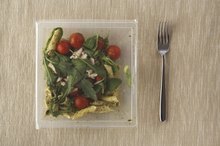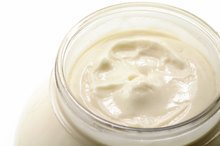14 Smart Ways to Cut Food Waste
We have a food-waste problem, and it’s hurting our wallets, our environment and the people most in need. According to a 2012 report by the National Resources Defense Council (NRDC), America throws out approximately 40 percent of its food every year, totaling $165 billion in wasted groceries: That equals more than 20 pounds of food per person each month! We’re squandering valuable resources used to grow and transport food like water, energy and gasoline and sending tons of uneaten food to rot in landfills where it releases methane, a powerful greenhouse gas that contributes to global warming. Meanwhile, the food that’s thrown away could have been used to feed hungry families. In fact, the NRDC reports that, “Reducing losses by just 15 percent could feed more than 25 million Americans every year.” So what can you do to help? A lot, actually. Here are 14 places to start:
1. Don’t Worry About “Use By” Dates
For the most part, “use by” dates are not federally regulated and typically have nothing to do with food safety. “Use by” and “best if used by (or before)” dates refer to food quality, not safety, according to the NRDC. Jennifer Quinlan, Ph.D., associate professor at Drexel University, considers the “use by” date a freshness guide, not a hard-and-fast rule. Two caveats: 1) The only “use by” date that’s federally regulated and must be followed is on infant formula, says JoAnne Berkenkamp of the NRDC; and 2) To reduce your chance of getting sick from Listeria, use precooked and ready-to-eat foods as soon as possible and throw them away after the “use by” date, as recommended by the Centers for Disease Control and Prevention. Listeria is a rare but serious food-borne infection, commonly found in raw and ready-to-eat foods like raw vegetables, sprouts and deli meats, and it can multiply in refrigerated temperatures. Older adults, pregnant women, children and people with weakened immune systems must be especially careful, says Quinlan.
Read more: 20 Foods to Always Buy Organic
2. Get More Out of Your Produce Scraps
How to Prevent Bacterial Growth in Food
Learn More
Save money and reduce your food waste footprint by turning produce scraps into vegetable stock. Fill a freezer-safe container with clean vegetable peels, roots, stalks and leaves, such as onion ends, leek stalks, carrot scraps, corncobs and leftover parsley. Avoid storing spoiled produce or strong-smelling vegetables like broccoli and Brussels sprouts. To make vegetable stock, Michelle Dudash, RDN, chef and author of “Clean Eating for Busy Families,” says to put the vegetable scraps in a pot and add water to cover, plus an inch. Simmer for an hour until it’s rich and flavorful, season to taste and then strain. “Vegetable stock is the easiest stock you can ever make in your life,” says Dudash. You can also eat the stems, leaves and peels of some fruits and vegetables like citrus peel, carrot, celery, fennel, turnip leaves, broccoli stalks, cauliflower leaves and greens. Pickle, zest, saute, puree, shred, juice, soup or toss them into a salad.
Listen now: How to Keep Your House Clean – Even When You're a Mess
3. Ask for Ugly Produce
“Ugly” produce is a term for imperfect-looking fruits and vegetables with the same nutrition profile and great taste of their perfect peers. While some ugly fruit and vegetables get donated or sold to processors, farmers are forced to throw away the rest because consumers only want to buy unblemished, ideal-looking food. While some misfit fruits and vegetables are malformed, JoAnne Berkenkamp at the National Resources Defense Council, says that, “In many cases, you’d need an expert or a machine to tell the difference” between ugly fruit and the kind we find at the market. The “ugly” movement has taken off in Europe, but it’s been slow to make waves in the United States. Talk to your retailer and let them know you’re interested in getting “ugly,” or “unsized, non-Grade A" produce, recommends Berkenkamp.
4. Use the “First In, First Out” System
Meal Planning Guidelines for a Low-Income Family
Learn More
Copy commercial kitchens and grocery stores, and use the “First In, First Out” (FIFO) system to reduce food waste. Keep food that will expire soon in the front of your refrigerator. For example, if you’ve accumulated a number of yogurt containers, put the ones that expire first in front of the ones that will last longer. JoAnne Berkenkamp at the National Resources Defense Council suggests designating a part of your refrigerator to quickly expiring food so you always see it when you open the door.
Read more: 16 Expert-Recommended Steps to Spring-Clean Your Kitchen
5. Compost at Home
Composting is a way to break down organic material like food waste and leaves so you can add it to soil and nourish growing plants. To compost, you need two basic ingredients: browns (dead leaves, branches, twigs, etc.) and greens (fruit and vegetable scraps, grass clippings, coffee grounds, etc.). You can make a compost pile in your backyard or use a sealed composting bin in the kitchen. If you don’t want to do it yourself, freeze your food scraps and drop them off at a local greenmarket, community garden or a composting friend’s home. To reduce odor, GrowNYC suggests lining the bottom of your freezer container with shredded newspaper. Cities like San Francisco and Oakland “have a curbside compositing collection for both food waste and yard waste,” says Darby Hoover, Senior Resource Specialist at the National Resources Defense Council, which means you can include items you can’t use in your home-composting system, like meat scraps.
Related: 20 Foods to Always Buy Organic
6. Manage Restaurant Portions
If a restaurant is notorious for huge portions (or if you’re not very hungry), ask for a half portion of your meal. Restaurants are often happy to serve smaller portions at reduced prices, even when they’re not listed on the menu, advises the NRDC. If you end up with leftovers and can refrigerate them within two hours, ask the restaurant to pack them up. Only half of Americans take leftovers from restaurants, reports the NRDC, leading to a lot of preventable food waste.
Read more: The 5 Worst Chain Restaurant Options and 5 Better-for-You Picks
7. Make “Kitchen Sink” Meals
“Everything but the kitchen sink” meals are the perfect way to clean out your refrigerator. Gather up neglected produce like baby carrots, leftover kale leaves and cherry tomatoes and turn them into a meal. Add leftover bits and pieces to a grain bowl with piping-hot rice, hot sauce and a poached egg; bake them into a frittata; or turn vegetables, beans and leftover meat into a soup. Michelle Dudash, RDN, gives her basic soup recipe: In a pot, saute a mix of chopped celery, carrots and onions in olive oil for five minutes. Add non-starchy vegetables, and saute until tender. Pour broth into the pot and add any starchy vegetables like potatoes along with add-ons like a chicken leg, noodles, herbs, canned beans or chopped tomatoes. Simmer until flavorful; puree the broth and vegetables for a smooth soup, or leave it chunky.
Read more: 10 Tricks to Save Money and Waste Less of Your Fresh Fruits and Veggies
8. Buy From Bulk Bins
If you don’t cook frequently or need a small amount of something, buy from bulk bins. Nuts, grains, beans, dried fruit, seeds and spices are usually available, in addition to granola, cereal and baking supplies. If cost is a concern, don’t assume all bulk food is less expensive than what’s on the shelf. A 2011 study by Portland State University said that consumers save an average of 89 percent by buying in bulk versus packages; however, a small 2012 NPR survey noted that nuts and seeds were more expensive in the bulk section. Always compare unit prices to find the best deal.
9. Freeze What You Can’t Use
You can safely freeze almost anything (except canned food or eggs in their shells), as long as the freezer is at or below 0 degrees Fahrenheit. Freeze food at its peak quality, not when it starts to go bad. While safety isn’t a concern, not all foods maintain their quality in the freezer. On Michelle Dudash’s freezer-worthy list? Stews, pasta sauces, casseroles, meatloaf, meatballs, anything out of a slow cooker, fresh vegetables and fruit and simmered meat like pulled pork or beef shoulder. If you seal the food well, Dudash says you can keep it for four to six months without a big loss in quality.
Read more: 16 Expert-Recommended Steps to Spring-Clean Your Kitchen
10. Keep Produce Front and Center
Keep fruits and vegetables in plain sight and skip the crisper drawers. “I like to call them Rest in Peace, or “RIP,” drawers because once they go in there you forget about them, then they spoil and you have to throw them away. Now that’s big-time waste,” says Dawn Jackson Blatner, RDN and author of the forthcoming book, “The Superfood Swap Diet.” Prep produce, store it in a clear container and keep it in the refrigerator at eye level so you’re more likely to eat it. Or keep it out on the counter and not hidden away in cupboards or drawers.
Read more: 10 Tricks to Save Money and Waste Less of Your Fresh Fruits and Veggies
11. Write Down the Date Opened or Frozen
Using a sharpie, record the date you opened a perishable product on the container. The manufacturer will typically tell you to use it within a few days of opening, and you’ll never have to wonder how long it’s been sitting on the shelf. The sharpie method works for leftovers too: Right before freezing, record the date on your leftovers. That way, you know how long it’s been in there and won’t prematurely trash something that was still good.
Read more: The 5 Worst Chain Restaurant Options and 5 Better-for-You Picks
12. Makeover Your Leftovers
If you want to reduce your food-waste footprint but loathe leftovers, give them a makeover. Create new meals by adding protein like sliced steak, roast chicken, seafood or tempeh to a salad, veggie-filled wrap, flatbread pizza, quesadilla or taco. Michelle Dudash, RDN, recommends turning a leftover vegetable tray into a stir-fry. Or whip up a salmon dip from cooked salmon -- just mash cooked salmon with light mayo, fresh herbs and dried seasonings and serve on crackers.
Read more: 10 Tricks to Save Money and Waste Less of Your Fresh Fruits and Veggies
13. Store Food Properly
Follow these three general guidelines to keep your food fresh as long as possible: 1) Refrigerate or freeze perishables immediately. Never allow food that requires refrigeration to sit out at room temperature for more than two hours (one hour if the temperature is 90 degrees or above). 2) Don’t crowd the refrigerator or freezer with food, which keeps cold air from circulating and cooling food to safe temperatures. 3) Use an appliance thermometer to ensure your refrigerator and freezer are at safe temperatures -- that means at or below 40° F in the refrigerator and 0° F in the freezer.
Read more: 16 Expert-Recommended Steps to Spring-Clean Your Kitchen
14. Donate What You Won’t Use
According to the U.S. Environmental Protection Agency (EPA), around 14 percent of American households do not get enough food to live active, healthy lifestyles. Instead of sending nutritious food to the landfill, give it to people in need. Donate nonperishables and unspoiled fresh food to local soup kitchens, shelters, food banks and food rescue programs. If you’re concerned about liability, all food donors who donate apparently wholesome food in good faith are protected from civil and criminal liability under the Good Samaritan Act, according to the EPA.
Read more: The 5 Worst Chain Restaurant Options and 5 Better-for-You Picks
What Do YOU Think?
Did you find any of these ideas helpful? What’s one thing you can start doing to reduce food waste? Do you have a great tip to share that we didn’t include? We would love to hear from you.
Read more: Food-Safety Mistakes You Don’t Know You’re Making
Related Articles
- amanaimagesRF/amana images/Getty Images









